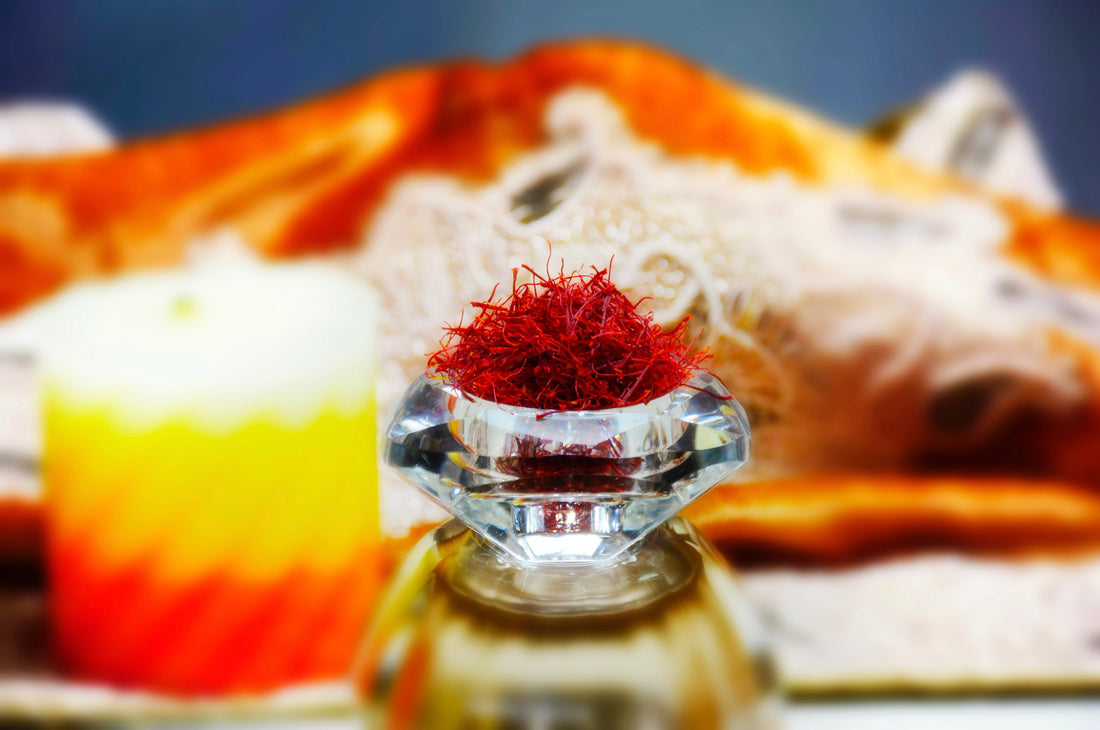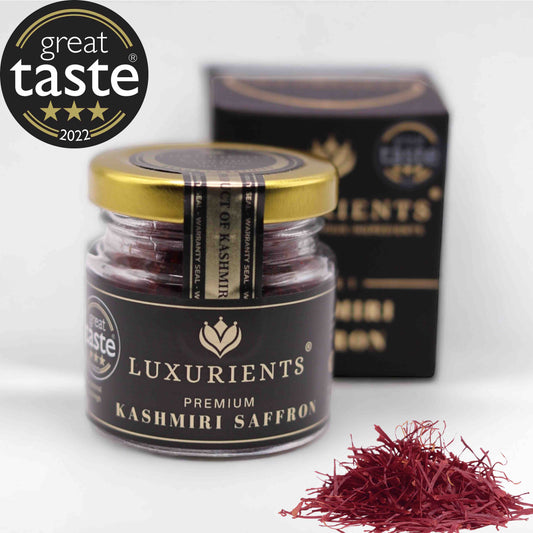
Which Saffron is best in the world?
Share
Determining the "best" saffron in the world can be subjective, as preferences may vary based on personal taste and culinary requirements. However, there are a few regions that are renowned for producing high-quality saffron. These regions include:
No1: Kashmir, India
On top of our list is Kashmir Saffron. Known for its saffron, this region produces saffron with a deep red colour, strong aroma, and robust flavour. Kashmiri saffron is highly regarded for its quality and is often considered among the finest in the world.
Kashmiri saffron, also known as Kashmiri Kesar or Kashmir Saffron, is highly regarded for its exceptional quality and is considered among the finest saffron varieties in the world. It is cultivated in the Kashmir region of India, where the climate and soil conditions create an ideal environment for saffron production.
Here are some key characteristics of Kashmiri saffron:
- Deep red colour: Kashmiri saffron threads have a rich and vibrant deep red colour, which is indicative of its high-quality and potency.
- Strong aroma: The aroma of Kashmiri saffron is intense and distinct, often described as floral, earthy, and slightly sweet. The fragrance adds depth and complexity to dishes.
- Robust flavour: Kashmiri saffron has a robust and distinct flavour that is often described as floral, honey-like, and slightly bitter. It lends a unique taste to a variety of culinary creations.
- High crocin content: Crocin is the compound responsible for the vibrant red colour of saffron. Kashmiri saffron is known for its high crocin content, which contributes to its intense colour and potency.
- Labour-intensive cultivation: The cultivation of Kashmiri saffron involves meticulous handpicking of the delicate saffron threads from the Crocus sativus flowers. This labor-intensive process ensures the preservation of saffron's quality and integrity.
Kashmiri saffron is sought after by chefs, culinary enthusiasts, and connoisseurs worldwide for its premium quality and unique flavour profile. It is used in a wide range of dishes, including rice pilafs, biryanis, desserts, and beverages. When purchasing Kashmiri saffron, it is advisable to source it from reputable suppliers who provide authentic and certified products to ensure you are getting genuine Kashmiri saffron.
No2: Iran
Iran is the largest producer of saffron globally, and its saffron is highly esteemed for its intense colour, distinct flavour, and potent aroma. Iranian saffron, often referred to as Persian saffron, is sought after for its superior quality.
When comparing Iranian saffron and Kashmiri saffron, both varieties have their own distinct characteristics and qualities.
Here's a comparison between Kashmir and Iranian Saffron:
- Colour: Both Iranian saffron and Kashmiri saffron exhibit a vibrant red colour. However, Kashmiri saffron is known for its slightly deeper red hue, while Iranian saffron tends to have a slightly brighter red colour.
- Aroma: Iranian saffron is renowned for its strong and distinct aroma, which is often described as floral, honey-like, and earthy. Kashmiri saffron also possesses a strong aroma but is often noted for its sweet and delicate fragrance.
- Flavour: Iranian saffron is characterised by a robust and slightly bitter flavour profile, with hints of floral and honey notes. Kashmiri saffron, on the other hand, is known for its subtle and slightly sweeter flavour.
- Crocin content: Both Iranian saffron and Kashmiri saffron have high crocin content, which contributes to their vibrant red colour. However, the exact crocin levels may vary depending on factors such as cultivation practices and growing conditions.
- Cultivation and origin: Iranian saffron is primarily cultivated in Iran, particularly in regions such as Khorasan. On the other hand, Kashmiri saffron is cultivated in the Kashmir region of India, which is known for its unique climate and soil conditions favourable for saffron production.
Ultimately, the choice between Iranian saffron and Kashmiri saffron depends on personal preference and the specific culinary application. Both varieties are highly esteemed and valued for their quality, and both have a long history of traditional use in various cuisines. However, based on above facts, Kashmiri Saffron is ranked as no.1 in our opinion and definitely has more of a superior premium look, taste and flavour.
No3: Spain
Spain is another prominent producer of saffron, particularly in the region of La Mancha. Spanish saffron is known for its sweet aroma, and delicate flavour. It is widely used in Spanish cuisine and is regarded globally.
While Spanish saffron is generally regarded as high-quality and sought after, there have been some concerns and issues associated with it.
Here are a few common issues that can arise with Spanish saffron:
- Counterfeit or adulterated saffron: Due to its popularity and high market value, there have been instances of counterfeit saffron being sold as Spanish saffron. Adulteration may involve mixing genuine saffron with lower-grade saffron or even substituting it with other spices or saffron substitutes. It is important to purchase Spanish saffron from reputable suppliers who can provide proof of authenticity.
- Variability in quality: While Spain is known for producing high-quality saffron, there can be variations in quality within different batches or grades of Spanish saffron. Some lower-grade Spanish saffron may have lower levels of the desired compounds such as crocin, which can affect its colour and flavour profile.
- Pricing: Spanish saffron can sometimes be more expensive compared to saffron from other regions. This is partly due to the cost associated with its cultivation and the meticulous hand-harvesting process. However, it is essential to be cautious of overly inflated prices that may not be justified by the saffron's quality.
- Packaging and storage: Improper packaging or storage of Spanish saffron can lead to a loss of aroma, flavour, and colour over time. It is recommended to store saffron in airtight containers, away from light and moisture, to preserve its quality.
Conclusion:
When selecting saffron, it is important to look for threads that are vivid red in colour, have a strong aroma, and are sourced from reputable producers. Additionally, certifications such as ISO 3632, which indicates the quality and grading of saffron, can be a useful guide in determining the quality of the saffron you are purchasing.
Luxurients Kashmiri Saffron is certified under international ISO 3632 and awarded with Grade 1 standard, which is the highest quality Saffron. The unique point about Luxurients Saffron is that they source Saffron directly from the growers in Kashmir and therefore, have full control over the high quality production. Luxurients Ltd is a UK based Saffron company established in the city of London. Recently, Luxurients also start to offer global shipping at a competitive shipping rate. If you are new to Luxurients, they offer a good discount on your first order with them! I will post a link below to their best selling Saffron.



7 comments
Very good
Do you export your product / saffron to Western Canada?
I’d appreciate more information.
Great post, thank you. I’m so glad I came across this blog as I had no idea which saffron is best in quality as I consume it daily with tea and milk. Kashmiri saffron is the best and to be honest, I did try Luxurients before and never found any other brand to match their quality. Going to order 5g this time :)
Best saffron
Totally agree and thanks for a great article Emma! Always pressure to read your posts. Being a chef, I always struggled to get high quality Saffron until I came across Kashmiri Saffron from Luxurients. I am so in love with their Saffron but also their customer service. Truly premium experience overall.